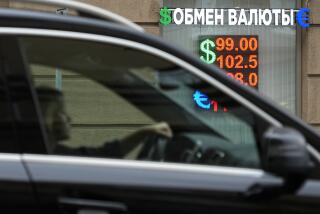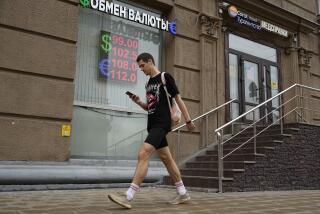Kremlin Plans to Sharply Devalue Its Currency : Soviet Union: The ruble will lose 90% of its value in some transactions. Officials hope to curb the black market in money.
- Share via
MOSCOW — The Soviet Union said Wednesday that it will shortly devalue its currency by 90% for some transactions in a bid to curtail the widespread black market speculation in hard currencies such as the U.S. dollar.
The new rate of 6.26 rubles to the dollar is a fraction of the present official rate of 0.63 rubles per dollar, reflecting the ruble’s limited buying power both at home and abroad. But it still does not match the current street rate of 10, 12 or often 15 rubles to the dollar.
Although the move will have a limited economic impact, it is probably the first of a series of “hard, unpopular measures” that President Mikhail S. Gorbachev warned earlier this week would be taken soon in order to pull the Soviet economy out of its deepening crisis.
The government newspaper Izvestia bluntly characterized the move as “a jolt,” and officials at the State Bank of the Soviet Union and the Ministry of Finance were so surprised by the government decision that they could not explain precisely how the new system would work.
The measure, however limited, is clearly a first step toward a broader devaluation of the ruble, fundamental price reforms and the eventual transformation of the ruble into a currency that could be bought and sold freely on the world’s currency exchanges.
The official Tass news agency said the devaluation would not solve all the country’s economic problems but added that the government viewed the move as “an important part of the economic reform, another step towards making the ruble convertible.” Tass also said the government hoped that “a more realistic rate of exchange” would attract more tourists and encourage businessmen to spend more here.
Described by the State Bank as simply a “special rate,” the new exchange rate will be used starting Nov. 1 for the hard currency sold to Soviet citizens going abroad, and for hard currency purchased from foreigners, presumably tourists and businessmen.
The official exchange rate would continue to be used for other transactions, according to an announcement by the State Bank. Most of Moscow’s foreign trade, however, is conducted in U.S. dollars, Swiss francs, German deutsche marks, British sterling or Japanese yen, and more than 3,000 different exchange rates are used to make Soviet prices comparable to those on the world market.
The official exchange rate has long been “an absurdity,” Izvestia said, commenting on the change, for it only tempted visiting tourists and businessmen to use the black market, which operates in virtually every tourist hotel and in free markets in almost every city.
“A more decisive measure had to be taken against this black market, which has sucked up a considerable amount of the hard currency brought into this country,” Mikhail L. Berger, Izvestia’s respected economic observer, said.
Speculators were taking “colossal advantage” of the disparity between the ruble’s artificially high value and the real buying power of foreign currencies, Berger said. The speculators usually buy hard currency at perhaps 10 times the official rate; use that money to buy prized consumer goods from special stores; sell the goods in rubles for upwards of 20 times their cost at the official rate, and then start the cycle over, taking a profit at each step.
“It’s the black market,” a Soviet banker said. “Too much hard currency is being lost there. We are going to try to choke off the flow of dollars and capture it ourselves.”
An economic commentator for Tass noted that “the Soviet currency has been weakened by difficulties arising during the restructuring of the Soviet economy, by the growing demand for almost all kinds of goods, the striving to get rid of rubles combined with the reduction in hard currency receipts from exports.”
“It is no secret that many Soviet citizens, and not only those who travel abroad on business, are striving to exchange their rubles for dollars, francs and yen,” Andrei Orlov wrote. “They use the services of the black market, and the exchange is certainly not made at the official rate. The state sustains considerable material losses at moral inconvenience to its citizens. The . . . government’s decision is aimed at correcting this situation.”
In the context of the overall Soviet economy, the immediate goal is to ensure that the state gathers as much foreign currency as it can from tourists and other visitors and retains as much as it can to finance imports.
Valery Ovcharenko, a spokesman for the Council of Ministers, which made the decision, described the change as an effort to attract more tourists by giving them more value for their money and encouraging Soviet citizens to exchange hard currency for rubles.
But the main focus, Ovcharenko said, was on the black market. The high prices paid for scarce consumer goods there have added to the country’s inflation. The recent growth of speculation has also undercut the first steps toward economic reform and angered many people who see political and moral degeneracy resulting from the economic liberalization.
Those likely to be hit hardest, at least initially, by the new system will be Soviet citizens who travel abroad, Berger said. At present, they are permitted to change 200 rubles into dollars at the official rate, bringing them about $320; after Nov. 1, the same 200 rubles will bring only $32.
The underlying difficulty remains the Soviet Union’s huge shortage of consumer goods and the $480 billion worth of savings held in state banks ready to buy anything of value or quality, often regardless of the price.
The new system is also a step toward making the ruble a freely convertible currency, a goal set for the year 2000.
“Although this exchange rate is being instituted only for non-commercial operations, it will undoubtedly influence the exchange rate for foreign trade as well,” Berger commented.
The auction will be closely watched for indications of the ruble’s real value, which may be as low as 5 cents, 3 cents or even 2 cents when measured in terms of the massive demand here for scarce consumer products such as audio and video equipment or gems and jewelry.
Last December, the Council of Ministers approved a plan for partial convertibility of the ruble, starting with a devaluation of 50% on most exports in January, 1990. That was tied to price reform and other domestic economic decisions, and little has been said about how that decision will be implemented.
A series of visiting American economists have urged Moscow recently to convert to a gold standard, using its massive holdings of gold to make the ruble convertible as a way of stabilizing the economy.
More to Read
Sign up for Essential California
The most important California stories and recommendations in your inbox every morning.
You may occasionally receive promotional content from the Los Angeles Times.












